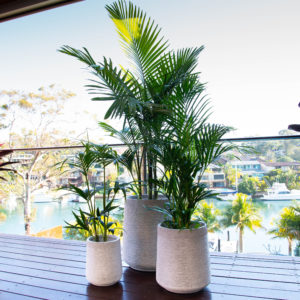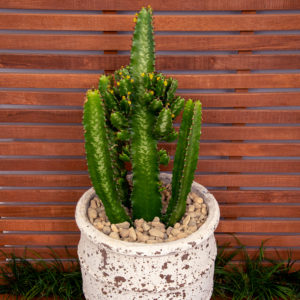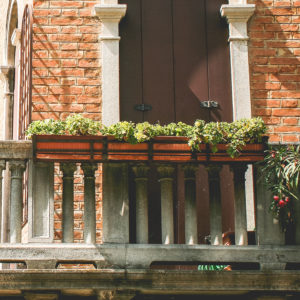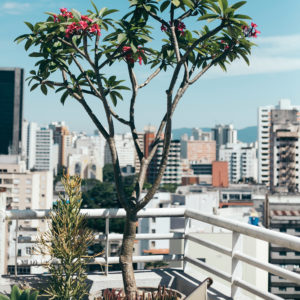Gardening 101: caring for your balcony garden
If you are new to gardening in containers on a balcony or other confined space, you may not know quite where to begin. Here are the answers to many frequently asked questions about small-space and balcony gardening.
Q. What kind of pots should I be using on my balcony?
A. There are many different pots that are suited to balconies. For ease of movement – particularly getting them onto the balcony in the first place – and for structural concerns so as not to put too much weight on a balcony, go for lightweight pots. These are made from types of plastic or other lightweight materials. Where weight isn’t a consideration, choose glazed pots as these are less likely to dry out than the other option, which is terracotta. Select heavy pots where balconies are exposed to strong winds and can bear the weight.

Grouping different-sized pots together looks great from a design perspective and helps keep everything grounded.
Q. Does size matter for pots?
A. Yes! Large pots provide better growing conditions for large plants. Select several large containers rather than lots of small pots, as larger pots can help create a uniform look. Grouping pots together also looks better from a design point of view and can help improve growing conditions for individual plants. Large containers grouped together will also be more resistant to wind. Lots of small pots scattered across a balcony can look bitty and are also harder to maintain.
Q. Are there any other tricks to know about containers?
A. The other important factor about pots is that they must have drainage holes in their base to provide good growing conditions inside the pots. Pots without drainage holes can be used as cover pots – that is, decorative outer pots that hold a plastic growing pot – but make sure it is possible to empty the drainage water from cover pots. Where the pot has drainage holes, make sure to have a saucer under the pot to catch drainage water so it doesn’t stain the surface of the balcony, create a slip hazard or drip down on to balconies below. Ideally, all pots should be slightly elevated to help with drainage and the best way to do this is to invest in pot ‘feet’, but if you like the DIY look, bricks can also be used. For more info on container gardening, this article has some great ideas.

Covering soil with pebbles isn't just great for decoration - it also helps prevent water evaporating too quickly.
Q. My plants receive a lot of intense afternoon sun as my balcony is high up and faces west. Is there a way to ensure that my plants retain the water that I give them, rather than it evaporating?
A. Watering is a big issue for containerised plants, especially those exposed to hot sun or wind. Glazed pots tend to retain water the best, followed by plastic. There are also self-watering pots available that have a water well built in which can supply a ready source of water. These work particularly well with ferns and foliage plants. Using a good-quality potting mix with added water-storing properties is also a good investment. To further reduce water loss, cover the surface of your potting mix with organic mulch such as lucerne, or alternatively with pebbles.
Q. What do I put into the pots to grow plants?
A. Always use a good quality potting mix for container growing. Look for mixes that meet the Australian Standard, as these will provide the best long-term growing medium for plants. There are special formulations available for terracotta containers and also for special types of plants such as azaleas and camellias, vegetables, cactus and succulents, orchids etc. For long-term container growing it is also possible to add bagged soil, aged manure or compost to your potting mix (around 10 per cent), which can improve the longevity of the potting mix.

Limited floor space? Planter boxes and troughs that will hang off your railing are a great option for balconies!
Q. I’d like to add some colour to my balcony but don’t have a lot of floor space for big pots. Are there other ways I can incorporate plant life?
A. It is definitely possible to grow plants making use of the vertical space on the balcony’s walls and also railings. Use vertical garden systems, trellises, wall or hanging baskets to add more plant colour and create more space for growing. These containers will also require extra attention when watering and may need wind protection on exposed balconies.
Q. I’m new to balcony and container gardening, but have experience with in-ground plants. Do care requirements differ?
A. Basically, potted plants tend to need more care on a regular basis than the same plant growing in the ground. Check them daily – and more frequently on hot or windy days. Water regularly, liquid feed plants that are actively growing and regularly deadhead and trim plants to keep them in check in confined spaces. Additionally, even though balconies are often a long way off the ground, pests can and do attack pot plants. Be vigilant for signs of caterpillars and other common garden pests.
Q. What do I do with plants on my balcony that don’t look healthy?
A. Be ruthless. In a confined growing space, plants need to look good all the time. This may mean being more ruthless than you would in a large garden. Plants may need to be removed if they stop flowering or develop growth, pest or disease problems. Take them away and replant with something new rather than spending a lot of time trying to nurse something back to health. Inject instant colour by buying advanced plants rather than starting with seedlings.
Want more tips on making the most of your small garden space? This article is full of them.


